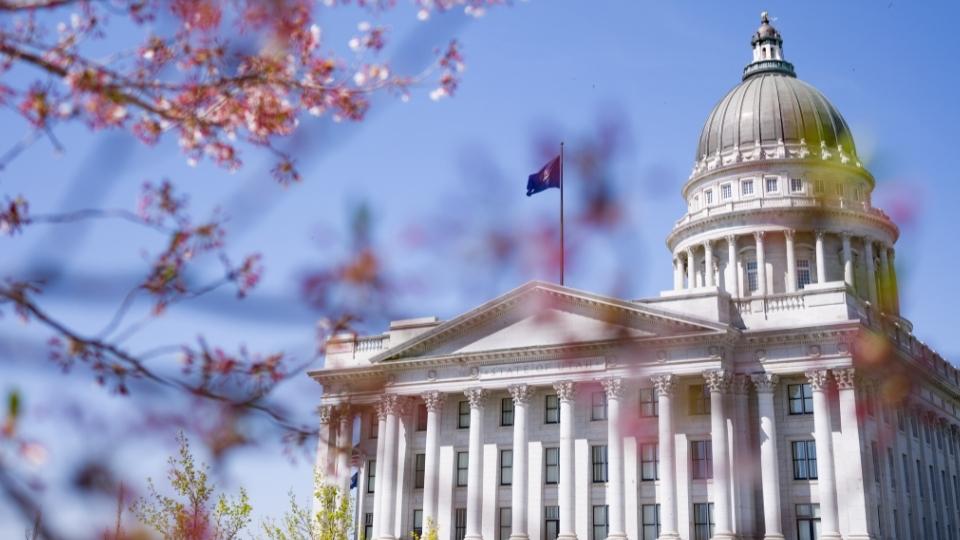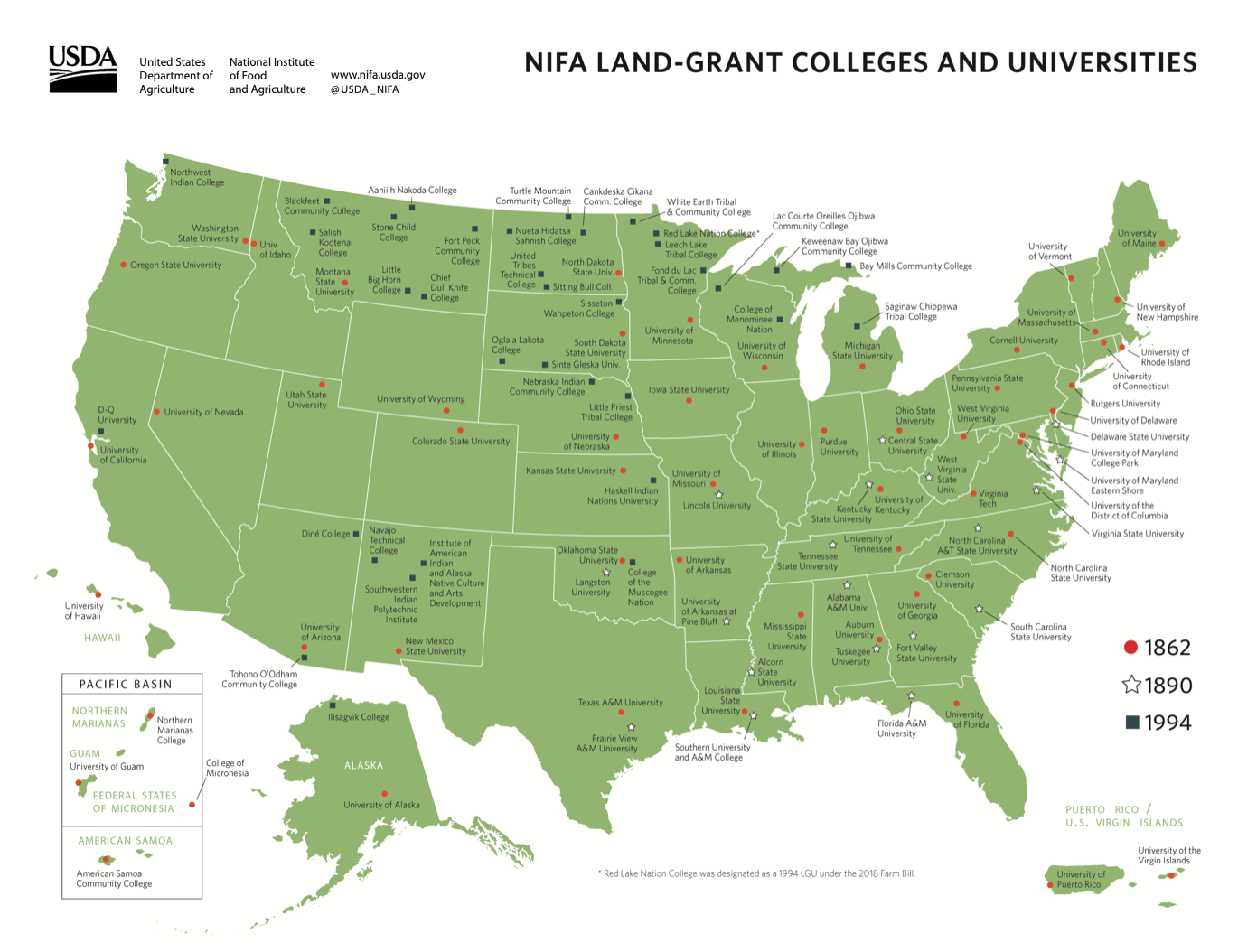The Purpose and Benefit of Land-grant (Extension) Universities

Utah State University is a land-grant university. That term often causes blank stares, since many people have never heard of land-grant universities, much less understand their purpose and the benefits they provide. To help raise awareness of what land-grant universities are and what they can do for the residents of Utah (and any other state), here’s an explanation.
What is a land-grant university?
A land-grant (or Extension) university is an institution that provides research-based programs and resources for residents within their state. There is at least one land-grant institution in every state and territory of the United States, as well as the District of Columbia. Each one is designated by the state legislature or Congress to receive benefits of the Morrill Acts of 1862, 1890, and 1994.
For over 100 years, land-grant status for universities has allowed grants/funding to be provided to produce practical research and information for the residents of each state. Due to the unavailability of higher education in many locations in the past, the initial intention of having land-grant universities was to provide practical education to agricultural and industrial workers. Now educational resources are provided to a much broader audience on a wide variety of topics.
“The original mission of these institutions, as set forth in the first Morrill Act, was to teach agriculture, military tactics, and the mechanic arts as well as classical studies so members of the working classes could obtain a liberal, practical education.”
Over the years, land-grant status has implied several types of federal support. The first Morrill Act provided grants in the form of federal lands to each state. The states used the proceeds from selling those federal lands to establish a public institution to fulfill the act’s provisions. At different times, money was appropriated through legislation such as the second Morrill Act and the Bankhead-Jones Act, although the funding provisions of these acts are no longer in effect.
A key component of the land-grant system is the Agricultural Experiment Station program, created by the Hatch Act of 1887. The Hatch Act authorized direct payment of federal grant funds to each state to establish an Agricultural Experiment Station in connection with the land-grant institution there. The amount of this appropriation varies from year to year and is determined for each state through a formula based on the number of small farmers there. A major portion of the federal funds must be matched by the state.
What is the Purpose of Land-grant Universities?
The purpose of a land-grant university is to provide readily available, research-based programs and educational resources with the goal of improving the lives of the individuals, families, and communities within the state.

Land-grant Universities Offer Helpful Programs and Resources
What Does a Land-grant University do?
Land-grant universities in each state across America provide research-backed programs, courses, events, research, and other resources that are available to the public on various relevant topics including:
Agriculture
- Agronomy (Crops)
- Ag Waste Management[BROKEN LINK]
- Agribusiness & Ag Economics
- Animal Health[BROKEN LINK]
- Beekeeping
- Livestock
- Coping with Farm Stress
- Dairy
- Diversified Agriculture
- Equine (Horses)
- Irrigation
- Poultry
- Production Horticulture[BROKEN LINK]
- Rural Tax Education
- Pest Management
- Small Farms
- Weed and Plant Management
Natural Resources
- Agronomy (Crops)
- Water-Efficient Landscaping
- Community-Based Conservation
- Field Guides
- Forestry
- Outdoor Recreation & Tourism
- Permaculture
- Rangelands
- Range Plants
- Stream-Side Science
- Sustainability
- Tree Species
- Biomass Resources
- Nature
- Water Impacts
- Water Quality
- Wetlands
- Wildlife Conflicts
Business and Community
- Finance (Personal and Family Money Management)
- Landscape Architecture & Environmental Planning
- Remote Work Training and Information
- Women & Leadership
- Small Business Development Centers
Food
- Canning
- Create Better Health
- Running a Food Business
- Food Preservation
- Food Safety
- Food Storage
- Hunger Solutions
- Nutrition
- Expanded Food & Nutrition Education
Health and Wellness
- Aging Resources
- Health & Wellness Resources
- Opioid Epidemic Resources for Mental Health
- Mental Health Education
Gardening
- Gardens & Centers
- Pests
- Tree Species and Information
- Water-Efficient Landscaping
- Yard & Garden Resources
Home
- Emergency Preparedness
- Home Buyer Education
- Healthy Living
- Sewing
- Child Cleanliness
Personal Finance
Relationships
Youth
Benefits of a Land-Grant University
Land-grant universities provide many benefits to individuals, families, and entire communities which include such things as:
- In-person and online educational courses (paid and free)
- Free tips on topics through emails, social media, websites, video tutorials, and more
- Free in-person and virtual events
- Readily available and practical research on a variety of topics
- Caring and knowledgeable experts who are available to help in each county
A Land-grant University Example
One example of a land-grant university is Utah State University. Founded in 1914 as part of the Smith-Lever Act, USU Extension plays a primary role in helping USU fulfill its land-grant mission. Though more than 100 years old, USU Extension is as vital as ever, and perhaps even more so, due to the increased diversity and complexity of the issues people encounter today. The integration of teaching, research, and public service enables USU Extension to respond to critical and emerging issues with research-based, unbiased information.
Two additional examples of land-grant universities include Texas A&M University and the University of Florida. See a comprehensive list of all the land-grant universities in the United states below.
How Many Land-grant Universities/Institutions are there?
There are 112 land-grant universities/institutions in the United States. Of these institutions, 19 are historically black and 33 are tribal. Each state and territory has one land-grant university that has been designated by the state legislature. Some states have more than one, due to the 2nd Morrill Act, and a few states have several because of the 1994 land-grant tribal colleges.

See NIFA Land-Grant Colleges and Universities by the USDA
Which Schools are Land-grant Universities?
The below list of land-grant universities in the United States are broken down by each state which include:
Alabama
- Alabama A&M University, Normal
- Auburn University, Auburn Tuskegee University, Tuskegee
Alaska
- Ilisagvik College, Barrow University of Alaska, Fairbanks
American Samoa
- American Samoa Community College, Pago Pago
Arizona
- Diné College, Tsaile
- University of Arizona, Tucson Tohono O’Odham Community College, Sells
Arkansas
- University of Arkansas, Fayetteville
- University of Arkansas at Pine Bluff, Pine Bluff
California
- D-Q University, (Davis vicinity)
- University of California System-Oakland as Headquarters, Oakland
Colorado
- Colorado State University, Fort Collins
Connecticut
- University of Connecticut, Storrs
Delaware
- Delaware State University, Dover
- University of Delaware, Newark
District of Columbia
- University of the District of Columbia,Washington
Florida
- Florida A&M University, Tallahassee
- University of Florida, Gainesville
Georgia
- Fort Valley State University, Fort Valley
- University of Georgia, Athens
Guam
- University of Guam, Mangilao
Hawaii
- University of Hawaii, Honolulu
Idaho
- University of Idaho, Moscow
Illinois
- University of Illinois, Urbana
Indiana
- Purdue University, West Lafayette
Iowa
- Iowa State University, Ames
Kansas
- Haskell Indian Nations University, Lawrence Kansas State University, Manhattan
Kentucky
- Kentucky State University, Frankfort
- University of Kentucky, Lexington
Louisiana
- Louisiana State University, Baton Rouge
- Southern University and A&M College, Baton Rouge
Maine
- University of Maine, Orono
Maryland
- University of Maryland, College Park
- University of Maryland Eastern Shore, Princess Anne
Massachusetts
- University of Massachusetts, Amherst
Michigan
- Bay Mills Community College, Brimely
- Keweenaw Bay Ojibwa Community College, Baraga Michigan State University, East Lansing
- Saginaw Chippewa Tribal College, Mount Pleasant
Micronesia
- College of Micronesia, Kolonia, Pohnpei
Minnesota
- Fond du Lac Tribal & Community College, Cloquet Leech Lake Tribal College, Cass Lake
- Red Lake Nation College, Red Lake
- University of Minnesota, St. Paul
- White Earth Tribal and Community College, Mahnomen
Mississippi
- Alcorn State University, Lorman
- Mississippi State University, Starkville
Missouri
- Lincoln University, Jefferson City
- University of Missouri, Columbia
Montana
- Blackfeet Community College, Browning
- Chief Dull Knife College, Lame Deer
- Aaniiih Nakoda College, Harlem Fort Peck Community College, Poplar
- Little Big Horn College, Crow Agency
- Montana State University, Bozeman
- Salish Kootenai College, Pablo
- Stone Child College, Box Elder
Nebraska
- Little Priest Tribal College, Winnebago
- Nebraska Indian Community College, Winnebago
- University of Nebraska, Lincoln
Nevada
- University of Nevada, Reno
New Hampshire
- University of New Hampshire, Durham
New Jersey
- Rutgers University, New Brunswick
New Mexico
- Navajo Technical College, Crownpoint
- Institute of American Indian and Alaska Native Culture and Arts Development, Sante Fe
- New Mexico State University, Las Cruces
- Southwestern Indian Polytechnic Institute, Albuquerque
New York
- Cornell University, Ithaca
North Carolina
- North Carolina A&T State University, Greensboro
- North Carolina State University, Raleigh
North Dakota
- Fort Berthold Community College, New Town
- Cankdeska Cikana Community College, Fort Totten
- North Dakota State University, Fargo
- Sitting Bull College, Fort Yates
- Turtle Mountain Community College, Belcourt
- United Tribes Technical College, Bismarck
Northern Marianas
- Northern Marianas College, Saipan, CM
Ohio
- Central State University, Wilberforce
- Ohio State University, Columbus
Oklahoma
- College of the Muscogee Nation, Okmulgee
- Langston University, Langston
- Oklahoma State University, Stillwater
Oregon
- Oregon State University, Corvallis
Pennsylvania
- Pennsylvania State University, University Park
Puerto Rico
- University of Puerto Rico, Mayaguez
Rhode Island
- University of Rhode Island, Kingston
South Carolina
- Clemson University, Clemson
- South Carolina State University, Orangeburg
South Dakota
- Oglala Lakota College, Kyle
- Sinte Gleska University, Rosebud
- Sisseton Wahpeton College, Sisseton
- South Dakota State University, Brookings
Tennessee
- Tennessee State University, Nashville
- University of Tennessee, Knoxville
Texas
- Prairie View A&M University, Prairie View
- Texas A&M University, College Station
Utah
- Utah State University, Logan
Vermont
- University of Vermont, Burlington
Virgin Islands
- University of the Virgin Islands, St. Croix
Virginia
- Virginia Tech, Blacksburg Virginia State University, Petersburg
Washington
- Northwest Indian College, Bellingham
- Washington State University, Pullman
West Virginia
- West Virginia State University, Institute
- West Virginia University, Morgantown
Wisconsin
- College of Menominee Nation, Keshena
- Lac Courte Oreilles Ojibwa, Community College, Hayward
- University of Wisconsin, Madison
Wyoming
- University of Wyoming, Laramie


 Utah 4-H & Youth
Utah 4-H & Youth